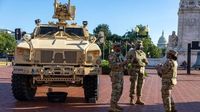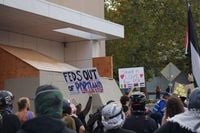Federal officers carried two protesters into the Immigration and Customs Enforcement (ICE) facility in Portland, Oregon, on the night of September 30, 2025, a scene emblematic of the escalating tension surrounding President Donald Trump’s nationwide deployment of National Guard troops. The move, part of a sweeping crackdown on what the administration calls crime-ridden cities, has sparked fierce debate over legality, cost, and the very fabric of American civil life.
Trump’s push to send American troops into major urban centers—often over the objections of local and state leaders—marks one of the most aggressive uses of federal force on domestic soil in recent memory. According to KATU, the 200 National Guard members now stationed in Oregon are tasked with protecting immigration officers and government facilities amid a series of ongoing protests near detention centers. These deployments, however, have been met with lawsuits, protests, and a chorus of local leaders arguing that the presence of troops only inflames tensions rather than restoring order.
During a Tuesday speech to military leaders, President Trump doubled down on his rhetoric, painting a dire picture of the nation’s cities. “We’re under invasion from within,” he declared. “No different than a foreign enemy, but more difficult in many ways because they don’t wear uniforms. At least when they’re wearing a uniform you can take them out.” Trump further suggested that U.S. cities could serve as training grounds for military forces, though he stopped short of providing specifics.
In Portland, the deployment is both costly and controversial. As reported by the Oregon Military Department on October 1, 2025, deploying 200 National Guard troops for 60 days is expected to cost nearly $3.8 million in pay alone—excluding meals, lodging, and transportation. Russell Gibson, the department’s government and legislative affairs director, explained to a legislative committee that training and logistics actually stretch the deployment to about 80 days, with one military police company and one infantry company identified for the assignment. Because Trump and Secretary of Defense Pete Hegseth federalized the troops, the federal government is responsible for these costs.
Local officials have not been shy about their opposition. Oregon Governor Tina Kotek, after filing a lawsuit seeking to block the deployment, stated, “When the president and I spoke yesterday, I told him in very plain language there is no insurrection or threat to public safety that necessitates military intervention in Portland or any other city in our state. Local law enforcement has this under control.” State Senator Anthony Broadman echoed support for the troops themselves, noting, “These are our brothers and sisters, our family members, our coworkers... and we recognize the situation that the president is putting them in.”
Despite the administration’s depiction of Portland as “war ravaged” and “an unmitigated disaster,” local residents have continued daily life with little disruption. According to Oregon Public Broadcasting, Portlanders have spent recent days working, hiking, attending concerts and farmers’ markets, and participating in largely peaceful protests outside ICE facilities. Recent demonstrations have even featured a group dance to the “Cha-Cha Slide” and a man dressed as a chicken, as seen in social media videos. Nonetheless, Trump remains adamant, telling military leaders, “Portland, Oregon, where it looks like a war zone, I get a call from the liberal governor, ‘Sir, please don’t come in, we don’t need you.’ I said, ‘Well, unless they are playing false tapes, this looked like World War II. Your place is burning down. I mean, you must be kidding.’”
Portland is hardly alone. The Trump administration has either deployed or threatened to deploy National Guard troops to more than half a dozen U.S. cities described as crime-ridden. In Illinois, 100 troops have been sent after weeks of Trump threatening to mobilize forces to Chicago. Democratic Governor JB Pritzker has pushed back, declaring, “With one voice, we are telling this unwarranted and unconstitutional occupation by ICE and potentially by military troops to get out of Chicago. You are not helping us.” Despite objections, an ICE facility near Chicago has become a focal point for tense protests and law enforcement crackdowns.
Memphis, Tennessee, is also in the administration’s sights. The Department of Justice reports that 219 officers have been “special deputized,” resulting in nine arrests and the confiscation of two illegal firearms on the first day of the operation. “Our operation in Memphis is now underway, and we’re just getting started,” U.S. Attorney General Pam Bondi announced on X. Louisiana Governor Jeff Landry has gone even further, requesting up to 1,000 National Guard troops to help combat crime in Shreveport, Baton Rouge, and New Orleans.
Washington, D.C., has seen some of the largest numbers, with thousands of National Guard troops deployed since August. The administration touts more than 2,000 arrests, over 200 firearms seized, and dozens of homeless encampments cleared as evidence of success. Yet, these actions have deepened rifts between federal officials and local leaders, who argue that the city’s autonomy is being eroded.
Not every city has welcomed the intervention. California Governor Gavin Newsom and Los Angeles Mayor Karen Bass condemned the summer deployment of troops to Los Angeles, calling it inflammatory and counterproductive. A federal judge in California sided with them earlier this month, ruling that Trump’s deployment of troops to Los Angeles violated the 19th-century Posse Comitatus Act, which restricts the use of federal troops in domestic law enforcement. The ruling found that Defense Secretary Pete Hegseth improperly expanded the National Guard’s duties to include security patrols, riot control, and crowd control. The decision is currently under appeal.
Legal experts, according to NPR, note a clear partisan divide: Democratic governors in states like California, Illinois, and Oregon have resisted the deployments, while Republican leaders have embraced them. Missouri Governor Mike Kehoe, for example, authorized the National Guard to assist with administrative and logistical duties at ICE facilities. The normalization of uniformed troops on American streets, some warn, could have lasting effects on the nation’s democratic traditions. Rosa Brooks, a Georgetown University law professor, observed, “It continues to get Americans used to the idea that that’s a normal thing, and that as you go about your daily business, you should just get used to it, and that’s the way it’s going to be. And is that intimidating? Is that chilling to most ordinary people? It is to a lot of people.”
As cities like Baltimore push back against the idea of National Guard deployments, and with lawsuits pending in Oregon and elsewhere, the debate over the balance between security and civil liberties shows no signs of abating. The coming weeks may prove decisive, as a federal judge in Portland prepares to hear arguments on a temporary restraining order that could halt the deployment while the larger legal battle unfolds.
With cities divided, legal challenges mounting, and the cost of deployments rising, the nation finds itself at a crossroads—one where the boundaries of federal power, local autonomy, and public safety are being tested in real time.

